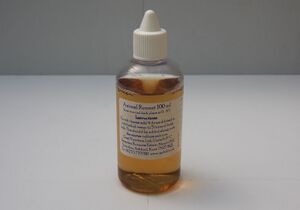Rennet

Rennet is an enzyme-containing substance produced in any mammalian stomach to digest the mother's milk, and is often used in the production of cheese. Rennet contains many enzymes, including a proteolytic enzyme (protease) that coagulates or sets the milk, causing it to separate into solids (curds) and liquid (whey). The active enzyme in rennet is called chymosin or rennin (EC 3.4.23.4) but there are also other important enzymes in it, e.g., pepsin or lipase. There are non-animal sources for rennet substitutes.
Production of natural calf rennet
Natural calf rennet is extracted from the inner mucosa of the fourth stomach chamber (the abomasum) of young calves. These stomachs are a by product of veal production. If rennet is extracted from older calves (grass-fed or grain-fed), the rennet contains less or no chymosin but a high level of pepsin and can only be used for special types of milk and cheeses. As each ruminant produces a special kind of rennet to digest the milk of its own mother, there are milk-specific rennets available, such as kid goat rennet especially for goats' milk and lamb rennet for sheep's milk. Rennet or digestion enzymes from other animals, such as swine-pepsin, are not used in cheese production.
Traditional method
Dried and cleaned stomachs of young calves are sliced into small pieces and then put into saltwater or whey, together with some vinegar or wine to lower the pH of the solution. After some time (overnight or several days), the solution is filtered. The crude rennet that remains in the filtered solution can then be used to coagulate milk. About 1 gram of this solution can normally coagulate 2000 to 4000 grams of milk.
Today this method is used only by traditional cheese-makers in central Europe: Switzerland, Jura, France, Romania, and Alp-Sennereien in Austria.
Modern method
Deep-frozen stomachs are milled and put into an enzyme-extracting solution. The crude rennet extract is then activated by adding acid; the enzymes in the stomach are produced in an inactive preform and are activated by the stomach acid. After neutralisation of the acid, the rennet extract is filtered in several stages and concentrated until reaching the required potency, usually about 1:15000 (meaning 1 kg of rennet would have the ability to coagulate 15000 litres of milk).
In 1 kg of rennet extract, there are about 0.7 grams of active enzymes – the rest is water and salt and sometimes sodium benzoate, E211, at a concentration of 0.5-1% as a preservative. Typically, 1 kg of cheese contains about 0.0003 grams of rennet enzymes.
Using rennet
This is only a rough guide as many factors such as milk-type, temperature and cheese recipe affect the setting ability of rennet.
Directions for animal and vegetarian rennet are identical.
Liquid rennet
Only a very small amount is required. About 2 drops per litre of milk for a hard cheese and 1 drop per litre for a soft cheese. Add the drops of rennet to a little cold pre-boiled water, mix well and whisk into the milk as directed by your recipe.
Powdered rennet
25 grams of powdered rennet will make 300 ml of liquid rennet and thus needs to be rehydrated before use. To do this, dissolve the powder in a 20% brine solution (60 grams salt in 250 ml cold pre-boiled water).
Use within 3 months once re hydrated.
Milk will curdle at 2 degrees higher when powdered rennet is used.
Find recipes that contain 'Rennet'
#cheese #whey #cheeses #goat #cheesemaking #vinegar #wine #sheepsmilk #curds #storecupboarditems #veal